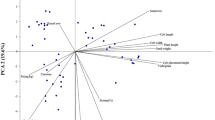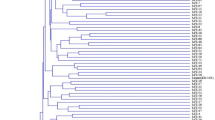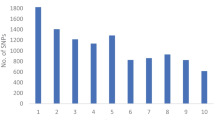Abstract
To determine the relationships and genetic diversity among the Mexican races of maize, 209 accessions representing 59 races were analyzed for 21 enzyme systems encoded by 37 loci; 154 out of the 209 accessions were grown in multiple locations and seasons in Mexico and 47 morphological characters were measured. A very high level of variation among and within the Mexican races was found. However, more than 65% of the alleles found in the accessions studied are rare, occurring at frequencies below 0.01. In addition, some populations have low levels of genetic diversity and have values of genetic differentiation similar to selflng crops. Most of the accessions with low values of genetic diversity are specialty varieties.
Résumé
Con el fin de determinar las interrelaciones y la diversidad genética entre las razas mexicanas de maíz, se analizaron 21 sistemas enzimdticos (37 loci) en 209 colecciones representantes de 59 razas; 154 colecciones del grupo anterior fueron sembradas en diferentes ambientes de Mexico y se midieron 47 caracteres morfológicos en forma directa. Los análisis de los datos mostraron que el maíz en Mexico posee niveles altos de variabilidad tanto entre como dentro de razas. Sin embargo, más del 65% de los alelos encontrados en las colectas estudiadas son raros, es decir, ocurren en frecuencias menores a 0.01. Adicionalmente, varias poblaciones tienen niveles bajos de diversidad y valores de diferenciación genética similares a especies autógamas. La mayoría de las accesiones con niveles bajos de diversidad genética son vaiedades para usos especiales. Key Words: Zea mays L., isozymes, genetic diversity, gnetic differentiation.
Similar content being viewed by others
Literature Cited
Anderson, E. 1943. Races ofZea mays II. A general survey of the problem. Acta Americana 1:58–68.
—. 1944. Maiz Reventador. Annals Missouri Botanical Garden 31:301–315.
—. 1946. Maize in Mexico. A preliminary survey. Annals Missouri Botanical Garden 33:147–247.
—,and H. C. Cutler. 1942. Races ofZea mays. I. Their recognition and classification. Annals Missouri Botanical Garden 29:69–88.
Benz, B. F. 1986. Taxonomy and evolution of Mexican maize. Unpublished Ph.D. dissertation, University of Wisconsin. 433 p.
Bretting, P. K., and M. M. Goodman. 1989. Karyological variation in Mesoamerican races of maize and its systematic significance. Economic Botany 43:107–124.
—,M. M. Goodman, and C. W. Stuber. 1987. Karyological and isozyme variation in West Indian and allied American Mainland races of maize. American Journal of Botany 74:1601–1613.
—,M. M. Goodman, and C. W. Stuber. 1990. Isozymatic variation in Guatemalan races of maize. American Journal of Botany 77:211–225.
—,and M. P. Widrlechner. 1995. Genetic markers and plant genetic resource management. Plant Breeding Reviews 13:11–86.
Cervantes S., T. 1976. Efectos genéticos y de interacción genotipo-ambiente en la clasificación de las razas Mexicanas de maíz. [Unpublished Ph.D. Dissertation]. Colegio de Postgraduados, Chapingo, Mexico, 139 p.
—,M. M. Goodman, E. Casas D., and J. O. Rawlings. 1978. Use of genetic effects and genotype by environmental interactions for the classification of Mexican races of maize. Genetics 90: 339–348.
Doebley, J. F., M. M. Goodman, and C. W. Stuber. 1983. Isozyme variation in maize from the southwestern United States: Taxonomic and anthropological implications. Maydica 28:94–120.
—,M. M. Goodman, and C. W. Stuber 1984. Isozyme variation in Zea (Gramineae). Systematic Botany 9:203–218.
Doebley, J. F., M. M. Goodman, and C. W. Stuber 1985. Isozyme variation in races of maize from Mexico. American Journal of Botany 72:629–639.
—,M. M. Goodman, and C. W. Stuber 1986. Exceptional genetic divergence of Northern Flint corn. American Journal of Botany 73:64–69.
—,M. M. Goodman, and C. W. Stuber 1987. Patterns of isozyme variation between maize and Mexican annual teosinte. Economic Botany 41:234–246.
—,J. D. Wendel, J. S. C. Smith, C. W. Stuber, and M. M. Goodman. 1988. The origin of Corn Belt maize: The isozyme evidence. Economic Botany 42:120–131.
Goodman, M. M. 1972. Distance analysis in biology. Systematic Zoology 21:174–186.
—,and R. McK. Bird. 1977. The races of maize. IV. Tentative grouping of 219 Latin American races. Economic Botany 31:204–221.
—,and E. Paterniani. 1969. The races of maize. III. Choices of appropriate characters for racial classification. Economic Botany 23:65–273.
—,and C. W. Stuber 1983. Races of maize. VI. Isozyme variation among races of maize in Bolivia. Maydica 28:169–187.
Hamrick, J. L. and M. J. W. Godt. 1989. Allozyme diversity in plant species. Pages 43–63in: A. H. D. Brown, M. T. Clegg, A. L. Kahler, and B. S. Weir, eds., Plant population genetics, breeding, and genetic resources. Sinauer Assoc, Sunderland, MA.
—and M. J. W. Godt 1997. Allozyme diversity in cultivated crops. Crop Science 37:26–30.
—,and J. D. Nason. 1996. Consequences of dispersal in plants. Pages 203–236in: O. E. Rhodes, R. K. Chesser, and M. H. Smith, eds., Population dynamics in ecological space and time. University of Chicago Press, Chicago.
Hernández C., J. M. 1986. Estudio de caracteres químicos del grano de las razas Mexicanas de maíz y clasificación racial. Unpublished M.S. thesis. Colegio de Postgraduados, Chapingo, México. 79 p.
Hernández X., E. 1993. Aspects of plant domestication in Mexico: A personal view. Pages {pp733-753}in: T. P. Ramamoorthy, R. fnBye, A. Lot, and J. Fa, eds., Biological diversity in Mexico, pmorigins and distribution. Oxford University Press.
—,and G. Alanís F. 1970. Estudio morfológico de cinco nuevas razas de maíz de la Sierra Madre Occidental de México: Implicaciones filogenéticas y fitogeográficas. Agrociencia 5:3–30.
Kato Y., T. A. 1976. Cytological studies of maize (Zea mays L.) and teosinte (Zea mexicana [Schrader] Kuntze) in relation to their origin and evolution. Massachusetts Agricultural Experiment Station, University of Massachusetts at Amherst. Bulletin No. 635.
—. 1984. Chromosome morphology and the origin of maize and its races. Evolutionary Biology 17:219–253.
Kelly, I., and E. Anderson. 1943. Sweet corn in Jalisco. Annals Missouri Botanical Garden 30:405–412.
Kuleshov, N. N. 1929. The geographical distribution of varietal diversity of maize in the world. Bulletin of Applied Botany, Genetics and Plant Breeding (Trudy Po Prikladnoi Botanike, Genetike I Selektsii) 20:506–510.
-. 1930. Maices de Mexico, Guatemala, Cuba, Panama y Colombia (Segün las colecciones de N.S. Bukasov). Pages 40-53in: Jorge Leon, translator, Las Plantas Cultivadas de Mexico, Guatemala y Colombia. CATIE, Turrialba, Costa Rica, 1981.
—. 1933. World’s diversity of phenotypes of maize. Journal of the American Society of Agronomy 25:688–700.
Lopez R., A., T.A. Kato Y., and F. Castillo G. 1995. Karyotypic characterization of the race Jala of maize. Maydica 40: 233–244.
Mangelsdorf, P. C. 1974. Corn. Its Origin, Evolution and Improvement. The Belknap Press of Harvard University Press, Cambridge, MA.
McClintock, B. 1978. Significance of chromosome constitutions in tracing the origin and migration of races of maize in the Americas. Pages 159–184in: D. B. Waiden, ed., Maize Breeding and Genetics. John Wiley and Sons, New York.
—,T. A. Kato Y., and A. Blumenshein. 1981. Chromosome Constitution of Races of Maize. Colegio de Postgraduados, Chapingo, Mexico.
Ortega P., R. 1979. Reestudio de las razas Mexicanas de maíz. Informe Anual. Campo Agricola Experimental de la Mesa Central. INIA, Chapingo, Mexico.
—. 1985. Variedades y razas Mexicanas de maíz y su evaluaciön en cruzamientos con lineas de clima templado como material de partida para fitomejoramiento.Abbreviated Spanish translation of Ph.D. thesis. N.I. Vavilov National Institute of Plants. Leningrad, U.S.S.R. 22 p.
Rohlf, F. J. 1993. NTSYS-pc. Numerical taxonomy and multivariate analysis system. Exeter Software, New York.
Ron P., J. 1977. Efecto de las radiaciones gamma de Co-60 en las razas de maíz de Mexico. Unpublished M.S. thesis. Colegio de Postgraduados, Chapingo, Mexico. 115 p.
Rzedowski, J. 1993. Diversity and origins of the Phanerogamic flora in Mexico. Pages 129-143in: T.P. Ramamoorthy, R. Bye, A. Lot and J. Fa, eds., Biological diversity in Mexico, origins and distribution. Oxford University Press.
Sanchez G, J. J. 1989. Relationships among the Mexican races of maize. Unpublished Ph.D. dissertation, North Carolina State University, Raleigh. 187 p.
—,and M. M. Goodman. 1992. Relationships among Mexican races of maize. Economic Botany 46:72–85.
—,M. M. Goodman, and J. O. Rawlings. 1993. Appropriate characters for racial classification in maize. Economic Botany 47:44–59.
Sanchez P., P. 1983. Estudio de estabilidad de caractères y razas de mafz de Mexico. Unpublished M.S. thesis. Colegio de Postgraduados, Chapingo, Mexico. 73 p.
SAS Institute, Inc. 1988. SAS/STAT User’s Guide Release 6.03 Edition. SAS Institute, Inc., Cary, NC.
Stuber, C. W., and M. M. Goodman. 1983. Inheritance, intracellular localization and genetic variation of phosphoglucomutase isozyme alleles in maize (Zea mays L.). Biochemical Genetics 21: 667–689.
—,and M. M. Goodman. 1984. Inheritance, intracellular localization and genetic variation of 6-phosphogluconate dehydrogenase isozyme in maize. Maydica 29:453–471.
—,M. M. Goodman, and F.M. Johnson. 1977. Genetic control and racial variation of ß-glucosidase isozymes in maize(Zea mays L.). Biochemical Genetics 15:383–394.
—,J. F. Wendel, M. M. Goodman, and J. S. C. Smith. 1988. Techniques and scoring procedures for starch gel electrophoresis of enzymes from maizeZea mays L.). Technical Bulletin 286. North Carolina Agricultural Research Service, North Carolina State University, Raleigh, NC., USA.
Vavilov, N. I. 1931. Mexico and Central America as the principal center of origin of cultivated plants of the New World. Bulletin of Applied Botany, Genetics, and Plant Breeding (Trudy Po Prikladnoi Botanike, Genetike I Selektsii) 26:179–199.
Wellhausen, E. J., L. M. Roberts, y E. Hernandez X., en colaboracion con P.C. Mangelsdorf. 1951. Razas de mafz en Mexico. Su origen, caractensticas y distribución. O.E.E., S.A.G. Folleto Técnico Num. 5.
Author information
Authors and Affiliations
Additional information
Isozymatic And Morphological Diversity In The Races Of Maize Of Mexico. Economic Botany 54(]):43–59, 2000.
Rights and permissions
About this article
Cite this article
Sanchez G., J.J., Goodman, M.M. & Stuber, C.W. Isozymatic and Morphological Diversity in the Races of Maize of Mexico. Econ Bot 54, 43–59 (2000). https://doi.org/10.1007/BF02866599
Received:
Accepted:
Issue Date:
DOI: https://doi.org/10.1007/BF02866599




